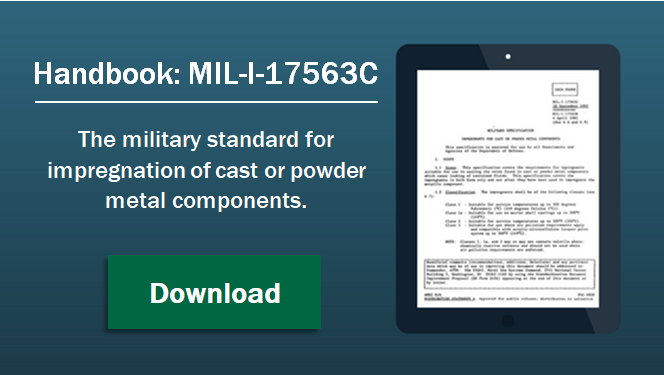MIL-I-17563C is the Military Specification for cast or powder metal components. This specification is approved for use by all Departments and Agencies of the Department of Defense and “covers the requirements for impregnants suitable for use in sealing the voids found in cast or powder metal components which cause leaking of contained fluids.”

To answer the question above, it’s important to first understand the 3 classifications within MIL-I-17563C.
Class 1 - Suitable for service temperatures up to 300°F (149°C)
Class 1a - Suitable for use on mortar shell castings up to 300°F (149°C)
Class 2 - Suitable for service temperatures up to 500°F (260°C)
Class 3 - Suitable for use where air pollution requirements apply and compatible with acrylic-nitrocellulose lacquer paint system up to 300°F (149°C)
In general, all organic based vacuum impregnation sealants are qualified to Class 1 and 3. Class 2 was designed specifically for sodium silicate which is in very limited use today, and Class 1a qualifies the sealant to be compatible with TNT (Trinitrotoluene) and Composition B explosives.
To qualify for MIL-I-17563C, the sealant is subjected to various tests including pot and storage life stability. Once activated, the sealant must be stable at 75 +/- 5°F (24 +/- 2.8°C) for one month for thermal cure and 45 +/- 5°F (8 +/- 2.8°C) for anaerobic while under aeration. Un-activated or un-catalyzed material in an unopened container must meet the manufacturer’s original specification at the end of one year from date of manufacture. All Godfrey & Wing sealants are approved for two (2) years.
The sealant reactivity to various metals including aluminum, copper, iron, magnesium and zinc is also tested. Samples must not exhibit any obvious surface defect such as holes, pits and fissures. Samples with copper shall not show a greenish coloration after exposure for 24 hours.
Godfrey & Wing currently has five sealants approved on QPL-17563 and are listed below:
95-1000 - Thermal curing
95-1000A - Thermal curing
95-1000AA - Thermal curing
95-1000AC - Anaerobic
95-1000ACP - Anaerobic
Conditioning testing under various test media, time and temperature are shown in Table 1.
TABLE 1 – Conditioning Tests
| Impregnation Class |
Material | Media Specifications |
Time | Temperature |
| 1 and 3 | Carbon Removal | P-C-111 | 30 minutes | 73.4 +/- 3.6 °F (23 +/- 2 °C) |
| 18% Sulfuric Acid | O-S-809 | 2 hours | 73.4 +/- 3.6 °F (23 +/- 2 °C) | |
| Turbine Fuel | MIL-T-5624 | 48 hours | 73.4 +/- 3.6 °F (23 +/- 2 °C) | |
| Fuel | ASTM D-910 | 48 hours | 73.4 +/- 3.6 °F (23 +/- 2 °C) | |
| Diester Grease | MIL-G-23827 | 48 hours | 73.4 +/- 3.6 °F (23 +/- 2 °C) | |
| Stoddard Solvent | P-D-680 | 48 hours | 73.4 +/- 3.6 °F (23 +/- 2 °C) | |
| Ethyl Alcohol | MIL-E-463 | 48 hours | 73.4 +/- 3.6 °F (23 +/- 2 °C) | |
| Hydrocarbon Fluid | TT-S-735 | 14 days | 73.4 +/- 3.6 °F (23 +/- 2 °C) | |
| Water | N/A | 14 days | 212 °F (100 °C) | |
| Oil | MIL-H-17672 | 14 days | 210 +/- 5 °F (99 +/- 2.8 °C) | |
| Hydraulic Fluid | MIL-F-17111 | 14 days | 210 +/- 5 °F (99 +/- 2.8 °C) | |
| Lubricating Oil | MIL-L-7808 | 48 hours | 255 +/- 5 °F (121 +/- 2.8 °C) | |
| Ethylene Glycol | MIL-E-9500 | 14 days | 300 +/- 5 °F (149 +/- 2.8 °C) | |
| Ethylene Glycol | MIL-E-9500 | 14 days | 397 +/- 5 °F (197 +/- 2.8 °C) | |
| Thermal Resistance | N/A | 14 days | 300 +/- 5 °F (149 +/- 2.8 °C) |




